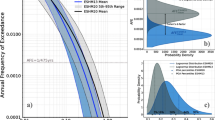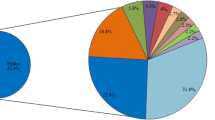Abstract
This study proposes a probabilistic methodology for estimating the business interruption loss of industrial sectors as an extension of current methodology. The functional forms and parameters are selected and calibrated based on survey data obtained from businesses located in the inundated area at the time of the 2000 Tokai Heavy Rain in Japan. The Tokai Heavy Rain was a rare event that hit a densely populated and industrialized area. In the estimation of business interruption losses, functional fragility curves and accelerated failure time models are selected to estimate the extent of damage to production capacity and production recovery time. Significant explanatory variables, such as inundation depth, distinct vulnerability, and the resilience characteristics of each sector, as well as the accuracy of fit of the model, are analyzed in the study. The function obtained and the estimated parameters can be utilized as benchmarks in estimating the probabilistic distribution of business interruption losses, especially in the case of urban flood disasters.









Similar content being viewed by others
Notes
Based on Rose (2004), higher-order effects include all effects on flows (e.g. goods or service) caused from the physical damages, such as interindustry, general equilibrium, or broader macroeconomic effects.
In fact, survey data about drop ratios of production capacity are continuous. The reason for adopting categorized data is for the benefit of loosening the assumptions required for our probability models. More parameters and assumptions are necessary for modeling the error terms in the case of the continuous model; we avoid this discussion by considering our case of limited dependent variables and small data sets.
References
Barker K, Baroud H (2014) Proportional hazards models of infrastructure system recovery. Reliab Eng Syst Saf 124:201–206
Cox DR (1972) Regression models and life-tables. J R Stat Soc Ser B (Methodol) 34(2):187–220
Dutta D, Herath S, Musiake K (2003) A mathematical model for flood loss estimation. J Hydrol 277(1):24–49
Federal Emergency Management Agency (FEMA) (2012) HAZUS 2.1 flood technical manual. https://www.fema.gov/media-library/assets/documents/24609?id=5120. Accessed 11 Nov 2015
Haimes YY, Horowitz BM, Lambert JH et al (2005) Inoperability input–output model for interdependent infrastructure sectors. I: theory and methodology. J Infrastruct Syst 11(2):67–79
Hallegatte S (2008) An adaptive regional input–output model and its application to the assessment of the economic cost of Katrina. Risk Anal 28(3):779–799
Heatwole N, Rose AZ (2013) A reduced-form rapid economic consequence estimating model: application to property damage from US earthquakes. Published articles & papers, Paper 202, April 2013. http://research.create.usc.edu/published_papers/202
Kajitani Y, Tatano H (2014) Estimation of production capacity loss rate after the Great East Japan earthquake and tsunami in 2011. Econ Syst Res 26(1):13–38
Kimura S, Ishikawa Y, Katada T, Asano K, Sato H (2007) The structural analysis of economic damage of offices by flood disasters in urban areas. Jpn Soc Civil Eng (JSCE) 63(2):88–100 (in Japanese)
Kleinbaum DG, Klein M (2005) Survival analysis. A self-learning text, 2nd edn. Springer, New York
Ministry of Land, Infrastructure, Transport and Tourism (MLIT) (2005) The manual for economic evaluation of flood control investments (in Japanese)
Nakano K, Kajitani Y, Tatano H (2013) Functional fragility curves for a production facility of industrial sectors in case of earthquake disaster. J Jpn Soc Civ Eng (JSCE): Struct Earthq Eng 69(1):57–68 (in Japanese)
Okuyama Y (2004) Modeling spatial economic impacts of an earthquake: Input–output approaches. Disaster Prev Manag Int J 13(4):297–306
Okuyama YD, Chang S (2004) Modeling spatial and economic impacts of disasters. Springer, Heidelberg, pp 13–19
Oliveri E, Santoro M (2000) Estimation of urban structural flood damages: the case study of Palermo. Urban Water 2(3):223–234
Rose A (2004) Economic principles, issues, and research priorities in hazard loss estimation. In: Modeling spatial and economic impacts of disasters. Springer Berlin, pp 13–36
Rose AZ, Liao SY (2005) Modeling regional economic resilience to disasters: a computable general equilibrium analysis of water service disruptions. J Reg Sci 45(1):75–112
Santos JR, Haimes YY (2004) Modeling the demand reduction input–output (I–O) inoperability due to terrorism of interconnected infrastructures. Risk Anal 24(6):1437–1451
Shinozuka M, Feng MQ, Lee J et al (2000) Statistical analysis of fragility curves. J Eng Mech 126(12):1224–1231
Smith DI (1994) Flood damage estimation—a review of urban stage-damage curves and loss functions. Water SA 20(3):231–238
Tatano H, Tsuchiya S (2008) A framework for economic loss estimation due to seismic transportation network disruption: a spatial computable general equilibrium approach. Nat Hazards 44(2):253–265
Acknowledgments
This work was conducted under the framework of the “Precise Impact Assessments on Climate Change” of the Program for Risk Information on Climate Change (SOUSEI Program) supported by the Ministry of Education, Culture, Sports, Science, and Technology in Japan (MEXT). The questionnaire data used in this study were provided by the Ministry of Land, Infrastructure, Transport, and Tourism (MLIT).
Author information
Authors and Affiliations
Corresponding author
Rights and permissions
About this article
Cite this article
Yang, L., Kajitani, Y., Tatano, H. et al. A methodology for estimating business interruption loss caused by flood disasters: insights from business surveys after Tokai Heavy Rain in Japan. Nat Hazards 84 (Suppl 1), 411–430 (2016). https://doi.org/10.1007/s11069-016-2534-3
Received:
Accepted:
Published:
Issue Date:
DOI: https://doi.org/10.1007/s11069-016-2534-3




